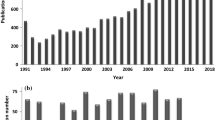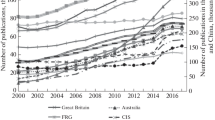Abstract
A longitudinal bibliometric analysis of publications indexed in Thomson Reuters’ Incites and Elsevier’s Scopus, and published from Persian Gulf States and neighbouring Middle East countries, shows clear effects of major political events during the past 35 years. Predictions made in 2006 by the US diplomat Richard N. Haass on political changes in the Middle East have come true in the Gulf States’ national scientific research systems, to the extent that Iran has become in 2015 by far the leading country in the Persian Gulf, and South-East Asian countries including China, Malaysia and South Korea have become major scientific collaborators, displacing the USA and other large Western countries. But collaborations patterns among Persian Gulf States show no apparent relationship with differences in Islam denominations.




Similar content being viewed by others
References
Arab League. (n.d.). From https://en.wikipedia.org/wiki/Arab_League-Iran_relation.
De Bruin, R. E., Braam, R. R., & Moed, H. F. (1991). Bibliometric lines in the sand. Nature, 349, 559–562.
Frame, J. D., & Carpenter, M. P. (1979). International research collaboration. Social Studies of Science, 9, 481–497.
Gringas, Y. (2014). How to boost your university up the rankings. University World News. (329), July 18, 2014. http://www.universityworldnews.com/article.php?story=20140715142345754.
Gul, S., Nisa, N., Shah, T. A., Gupta, S., Jan, A., & Ahmad, S. (2015). Middle East: Research productivity and performance across nations. Scientometrics, 105, 1157–1166.
Haass, R. N. (2006). The New Middle East. Foreign Affairs. https://www.foreignaffairs.com/articles/middle-east/2006-11-01/new-middle-east.
Islam. (n.d.). Information was obtained from a series of articles available at https://en.wikipedia.org/wiki/Islam_in_X, X being the name of the country.
Kotsemir, M., Kuznetsova, T., Nasybulina, E., & Pikalova, A. (2015). Identifying directions for the Russia’s Science and Technology Cooperation. Foresight and STI Governance, 9, 54–72.
Moed, H. F., & Halevi, G. (2014). Tracking scientific development and collaborations: The case of 25 Asian countries. Research Trends, (38).
Sharafedin, B. (2016). Iran’s leader says never trusted the West, seeks closer ties with China. Markets, January 23, 2016. http://www.reuters.com/article/us-iran-china-idUSKCN0V109V.
UNESCO. (2014). Higher education in Asia: Expanding out, expanding up. ISBN 978-92-9189-147-4 licensed under CC-BY-SA 3.0 IGO. Montreal: UIS. http://www.uis.unesco.org.
Van Eck, N. J., Waltman, L., Dekker, R., & Van den Berg, J. (2010). A comparison of two techniques for bibliometric mapping: Multidimensional scaling and VOS. Journal of the American Society for Information Science and Technology, 61(12), 2405–2416.
Wakefield, B., & Levenstein, L. (Eds.). (2011). China and the Persian Gulf: Implications for the United States. Washington, D.C: Woodrow Wilson International Center for Scholars.
Waltman, L., Van Eck, N. J., & Noyons, E. C. M. (2010). A unified approach to mapping and clustering of bibliometric networks. Journal of Informetrics, 4(4), 629–635.
Acknowledgments
The author wishes to thank Thomson Reuters for providing access to Incites, and the Sapienza University of Rome for offering its library facilities, especially access to Elsevier’s Scopus.com.
Author information
Authors and Affiliations
Corresponding author
Rights and permissions
About this article
Cite this article
Moed, H.F. Iran’s scientific dominance and the emergence of South-East Asian countries as scientific collaborators in the Persian Gulf Region. Scientometrics 108, 305–314 (2016). https://doi.org/10.1007/s11192-016-1946-x
Received:
Published:
Issue Date:
DOI: https://doi.org/10.1007/s11192-016-1946-x




